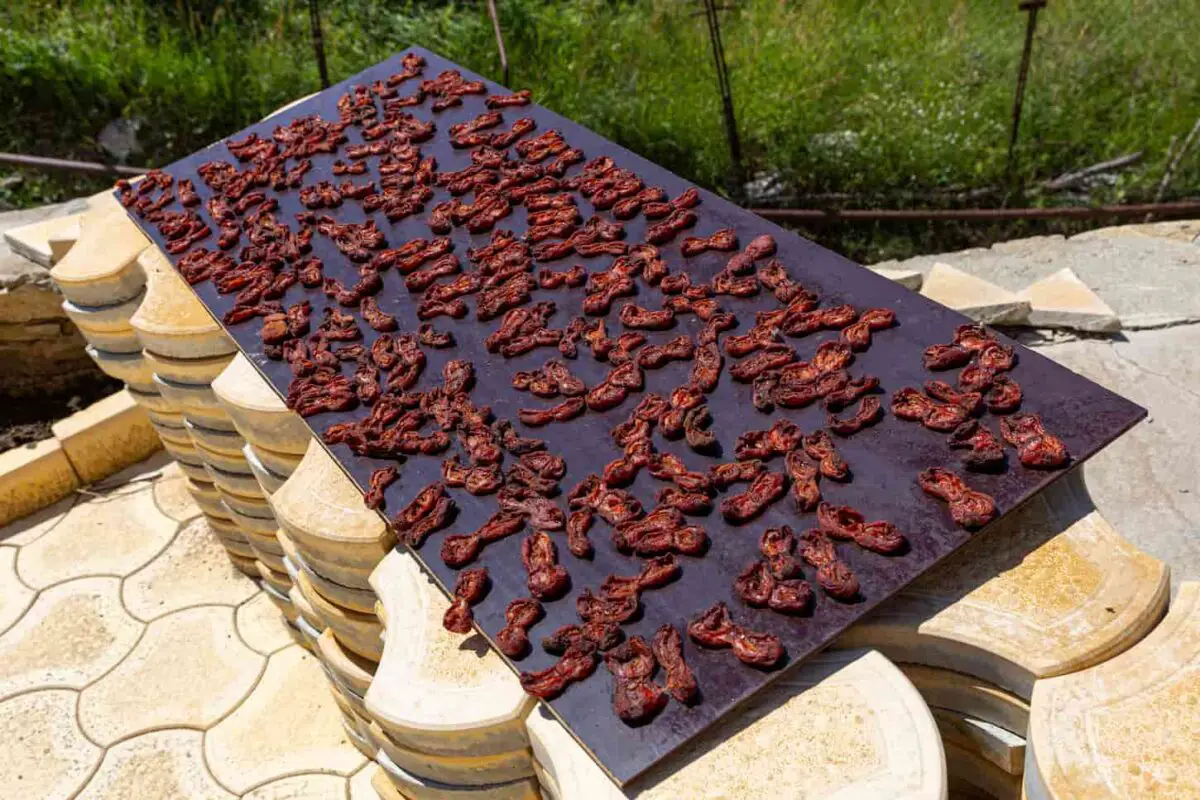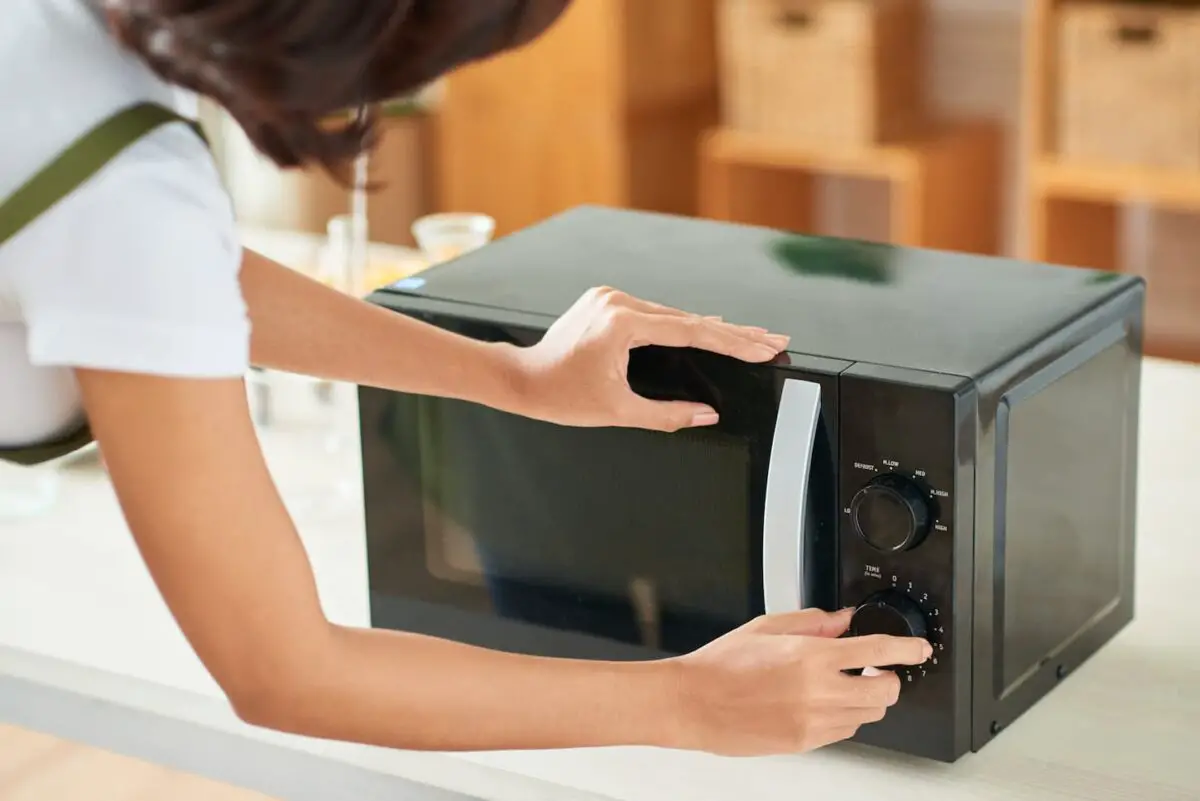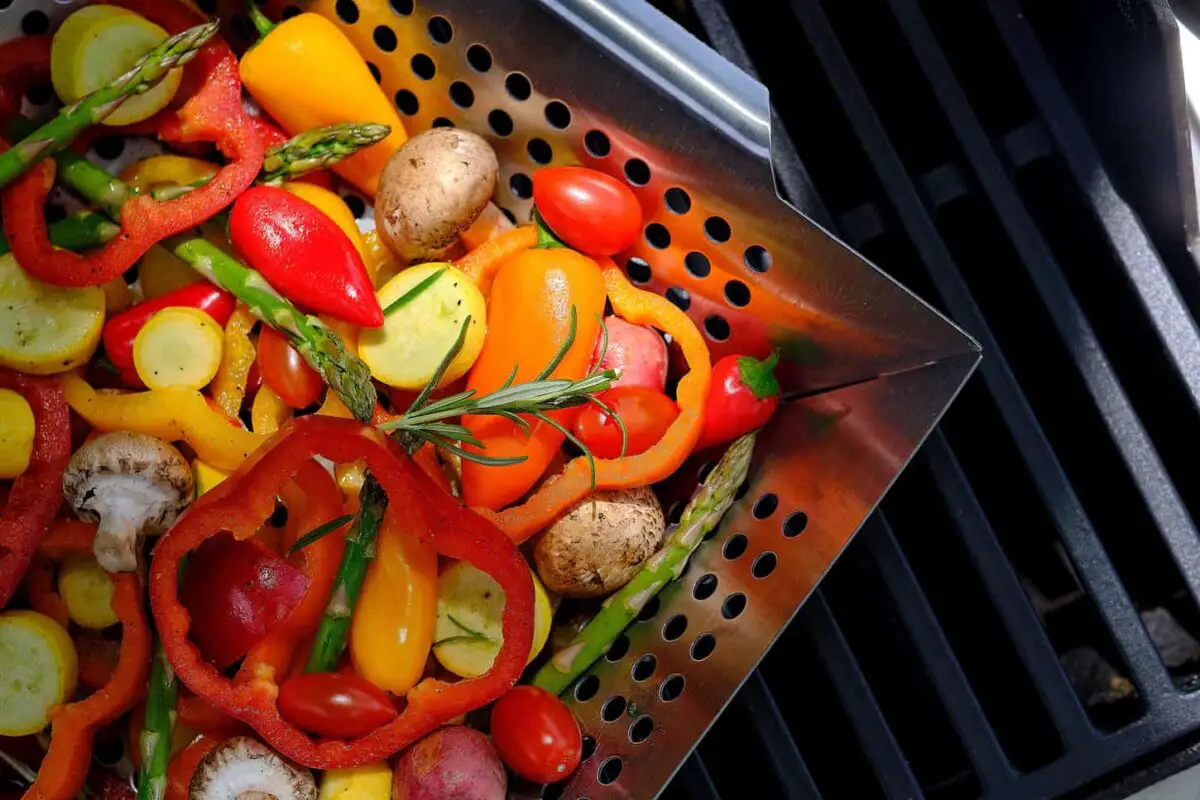While a food dehydrator is the best and most efficient method of dehydrating food (both economically and time-wise), they come at a price. If you can’t afford one or want to test home-dried foods before investing in any devices, here’s how to dry food without a dehydrator.
The most common methods to dehydrate food without a dehydrator are in an oven, microwave, air-fryer, sun, out in the air (including smoking foods), and solar dehydration. People can also build their own food dehydrator using one (or several) of the above methods.
Not all these methods are the same, so read on to learn the best alternatives, their pros and cons, and how to use some of them.

What Can I Use If I Don’t Have a Dehydrator?
People can dehydrate food in ovens, microwaves, air fryers, smokers, hot air, or sun. The sun’s power can best be harnessed to dehydrate food with a solar (sun) dryer or dehydrator. Lastly, food can be dehydrated by being smoked or air-dried, too.
Before we delve into every single option, just a reminder that different options suit different foods. For example, we can’t use the microwave to dry meat or fruit.
Oven drying
Drying food in the oven is the usual go-to method if we don’t have a food dehydrator. The good news is – we can dehydrate all foods in the oven.
The bad news is – it will take a lot of time, cost more money than a dedicated dehydrator, consume a lot of our energy, and the results might not be as good as a dehydrator.
There are several reasons for this. Firstly, an oven requires much more electricity than an average food dehydrator. We’ll spend about $0.165 to run a dehydrator for an hour. But running an oven for an hour can cost up to $0.379.
Dehydrating 100 hours a month will cost about $38 with an oven but only $16 with a dehydrator. If we save up to $38 a month for three months, we can buy a decent dehydrator for that money!
Speaking of time – drying food in an oven will take up a good chunk of time. Because most ovens can’t be set low enough (it needs to be set at a max 140 degrees Fahrenheit, and my oven’s lowest temperature is 200 degrees), the temperature needs to be constantly checked and adjusted.
Another stark difference between an oven and a dehydrator is that air doesn’t circulate in an oven, and we’ll have to prop the door open to let the moisture out. Keeping the door open will also help keep the temperature in the right range, but it’s not guaranteed – you’ll still need to check it regularly.
This means that the temperature will most likely fluctuate, requiring constant care on our part. We have to check on the oven every once in a while, whereas a dehydrator is a machine we can turn on and let work on its own.
Because of the lack of airflow, drying food in an oven is about twice as slow as drying it in a dehydrator. For the same reason, food can sometimes burn if we don’t regulate the temperature properly.
Drying food in an oven is possible, but it’s inferior quality and a ton more time and work than a dehydrator, and we recommend trying some of the other options.
Solar drying
We’ll get to sun drying in a bit, but first, let’s talk about solar drying. Solar drying is an updated version of classic dehydrating food drying methods that have seen great success in sunny areas. If we have at least 10 hours of sunlight a day, we can solar dry.
We must build a solar dryer. A solar dryer can be a simple, chair-like construction with transparent foil covering the top. The sides remain open for air circulation. You can also cover the sides with saran wrap to keep out bugs and birds. Just do it loosely, so there’s still airflow.
On a sunny day, all we have to do is put the food we want to dry on a tray and insert it in the dryer. The foil will cause the greenhouse effect and increase the temperature drastically, essentially mimicking an oven.
However, since the sides are left open, the air will circulate, letting the moisture out, and the food dries.
While this design is simple and effective, two major flaws exist. Firstly, it’s completely useless indoors or if we live in a place that doesn’t get a lot of sunlight.
Secondly, most homemade dryers can only fit a single tray inside, making it a slow process (although we can build a large dryer).
This article, published by the Austrian Development Cooperation and AEE INTEC, has several great designs, describing them in great detail. We recommend taking a look if you want to build your own dryer. The designs are fantastic, but some may be overkill for a basic backyard solar dryer (or dehydrator).
That’s why we’ve also got our guide on How Do You Make a Homemade Dehydrator? Complete How-To.
Air-drying
Drying food by simply leaving it hanging out is a method employed by people for thousands of years. Some vegetables, such as peppers, have a protective layer that allows them to dry but not rot when exposed to oxygen.
This is why they don’t need to be kept in a refrigerator to stay edible. To air-dry, all we have to do is tie down the food with a string and leave it hanging out. However, aside from peppers, we can air-dry very few foods safely (source), though herbs and mushrooms are often air-dried safely, too.
Smoking our food is another air-drying type; smoking meat is common worldwide. This process gives the meat flavor, but it also preserves it. You can smoke hams, bacon, sausages, and various fish.
There are three different methods of smoking meats – hot, cold, and liquid. Cold smoking isn’t generally recommended as it doesn’t eradicate microbes. Liquid smoking is a bit of a misnomer, as it’s not smoking the food – it just adds the smoked flavoring. So it’s not a way to preserve food – it’s just flavoring.
However, you can add liquid smoke to dehydrated foods to make them taste like smoked foods. For example, when we make jerky, we add a few drops of liquid smoke flavoring to our marinade for that smokey flavor. It adds extra depth to the jerky.
Finally, let’s talk about hot smoking – the process of cooking and smoking meat simultaneously (usually over a burning fire). To hot-smoke meats, we’ll need to buy a hot-smoking oven.
If you’ve got a backyard smoker, odds are it’s either a cold smoker (uses low temperatures), a hot smoker, or it can do both. I’m not an expert on smokers, though I enjoy a good smoked brisket.
Sun-dryer
Lastly, sun drying is the most primitive of all methods of food preservation. All you have to do is this: set the food on a stainless steel plate, put it in direct sunlight, and keep it lifted from the ground so air can circulate. This method isn’t viable if living in a place that doesn’t get a lot of sunlight or a humid place (anything more than 60% is a no-go).
However, this is just the beginning of the negatives. Since we’re leaving food outside to dry, we can expect birds and other would-be thieves to try and eat it.
This process is also painfully slow (unless we live in a literal desert), so it might take a day or two to dry some food.
The food may spoil during the process since it’s out in the open, where bacteria and microbes have constant access.
This is only an option if we live in a sunny, dry place, but even in that case, we’d still recommend drying the food in a solar dryer or oven. If you don’t have a dehydrator, do this purely for the sake of your own health.
If you live in a sufficiently sunny and not too humid place, you can eliminate the problems of sun-drying food by using a solar dehydrator. We’ve got the whole building process outlined in this article here.

Can You Dehydrate Food in a Microwave?
Some herbs and leafy vegetables can be dehydrated in small quantities in a microwave. However, microwave drying is not as successful for meat and fruit, and the results with other herbs are not that good.
The food will often taste overcooked because the air can’t circulate in a microwave. So, while it’s technically possible, the results aren’t as good as other methods.
To dry food in a microwave, put a few herbs or leafy green leaves between two paper towels and microwave them for two minutes. Let them cool down, and if they’re dry after cooling, we just dehydrated our own herbs.
If the leafy greens or herbs are not dried after 2 minutes, repeat the process in 30-second intervals.
Keep watch of the microwave during the entire process in case anything catches fire! Yes, it’s a real risk. I don’t dehydrate food in the microwave, nor do I recommend it.
Can I Use My Air Fryer to Dehydrate Food?
We can use an air fryer to dehydrate food. Some air fryers have a ‘dehydrate’ mode for food drying. They essentially work the same way as dehydrators, albeit they are less efficient as this is not their primary purpose.
If the air fryer has a ‘dehydrate’ function, then choose it, fill it with the food in question, and follow the instructions from the manual.
If it doesn’t have that function, we can still dry food. We have to choose the lowest temperature setting (jerky cooks at temperatures above 140°F, and fruits and veggies shouldn’t go above 123°F) and lay the food down in a single layer.
The time it takes for an air fryer to dehydrate food will depend on the model, but it’s safe to assume it will take more time than a dehydrator. Check on the food regularly to make sure it’s progressing. Test the food after a few hours to see if it’s ready.
Can You Make a DIY Dehydrator at Home?
We can make a solar dehydrator that utilizes sunlight to heat the food inside and let it dry. Unfortunately, this method is only viable for people in warm climates that get a lot of sunlight. Indoor food dehydrators are also possible but are a bit more difficult to make.
We already talked about solar dehydrators in this article, and if you want to build one, feel free to follow the link from that section to dozens of designs.
Making an indoor electric dehydrator is a bit more complex as it involves electricity, but it’s still doable. After all, a dehydrator is just a box with a source of heat and a built-in fan for air circulation – nothing more than that.
Find out more in our How Do You Make a Homemade Dehydrator? Complete How-To article.

Key Takeaways and Next Steps
The easiest way to dehydrate without a dehydrator is with an air fryer or a homemade solar fryer. Ovens work too, but they take a lot of work and cost a lot of money to run. Air-drying and smoking are viable options for some foods, while sun-drying is potentially dangerous because the food is exposed to bugs, birds, and pathogens.
However, you can make sun-drying safer by using a solar dehydrator. If you haven’t read our article on that already, make sure you read it next by clicking here.
Otherwise, check out our dehydrating food hub here: What Is the Best Way to Dehydrate Food? It’ll link you to all our dehydrating articles, making it super easy to find what you want to read on dehydrating next.
Resources
Learning from your own experience is essential, but learning from others is also intelligent. These are the sources used in this article and our research to be more informed as homesteaders.
- Curing and smoking meats for Home Food Preservation Literature Review and Critical Preservation Points. Curing and Smoking Meats for Home Food Preservation. (n.d.). Retrieved January 20, 2023, from https://nchfp.uga.edu/publications/nchfp/lit_rev/cure_smoke_postproc.html
- Driessen, S. (n.d.). Drying food at home. UMN Extension. Retrieved January 20, 2023, from https://extension.umn.edu/preserving-and-preparing/drying-food
- Naitor, S. (2019, May 30). Solar Dryer. Academia.edu. Retrieved January 20, 2023, from https://www.academia.edu/39312859/Solar_Dryer